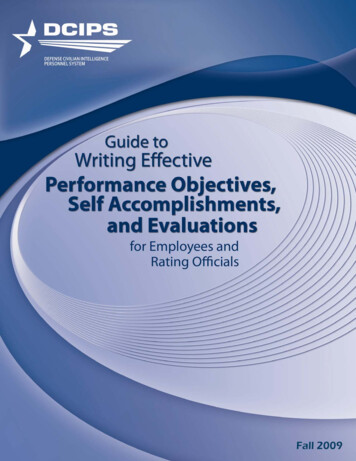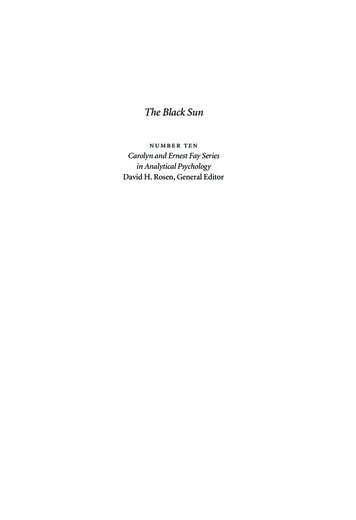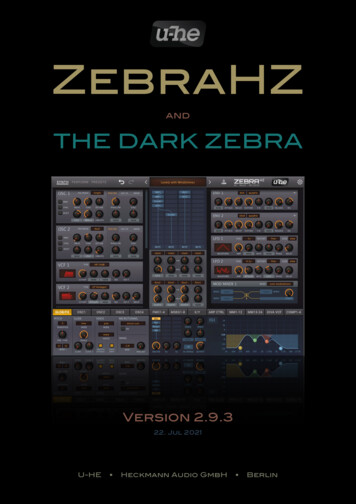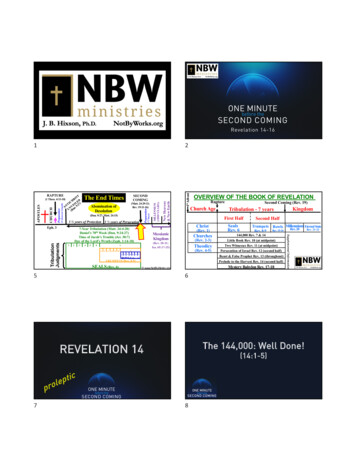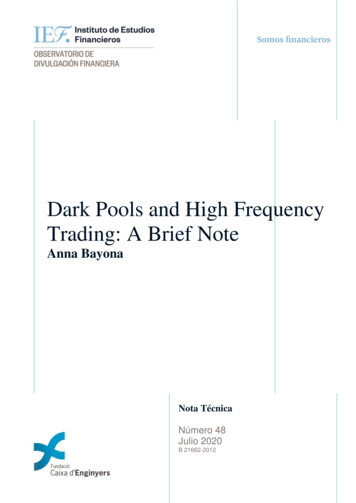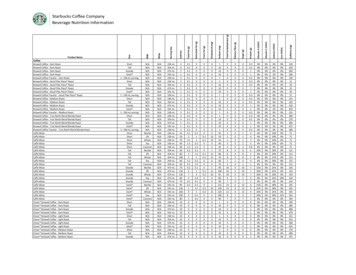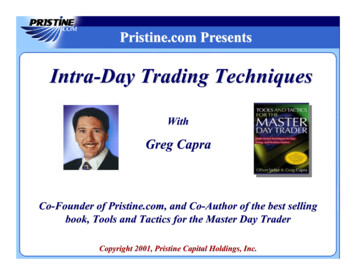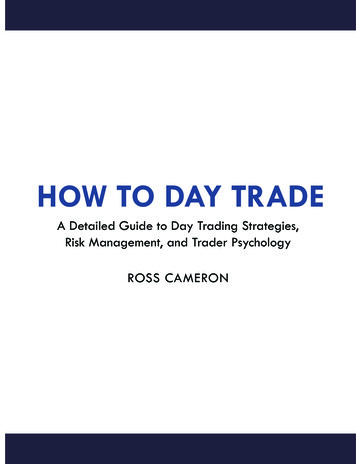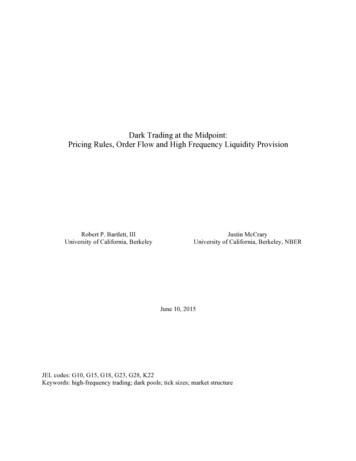
Transcription
Dark Trading at the Midpoint:Pricing Rules, Order Flow and High Frequency Liquidity ProvisionRobert P. Bartlett, IIIUniversity of California, BerkeleyJustin McCraryUniversity of California, Berkeley, NBERJune 10, 2015JEL codes: G10, G15, G18, G23, G28, K22Keywords: high-frequency trading; dark pools; tick sizes; market structure
Dark Trading at the Midpoint:Pricing Rules, Order Flow, and High Frequency Liquidity ProvisionAbstract:Using over eight trillion observations of market data, we use a regressiondiscontinuity design to analyze the effect of increasing the minimum pricevariation (MPV) for quoting equity securities in light of recent proposals toincrease the MPV from 0.01 to 0.05. We show that a larger MPV encouragesinvestors to trade in dark venues at the midpoint of the national best bid and offer.Enhanced order flow to dark venues reduces price competition by exchangeliquidity providers, especially those using high frequency trading (HFT). Tradingin dark venues due to a wider MPV reduces volatility and increases tradingvolume.
1. IntroductionA central question for the organization of equity markets is how to provide incentives fortraders to provide liquidity on public stock exchanges while protecting the interests of traderswanting to access it. By standing ready to buy or sell a security at disclosed prices, liquidityproviders allow liquidity takers to execute trades immediately, facilitate the continuous pricingof securities on which markets depend, and most fundamentally, encourage the holding ofsecurities in the first place. Yet given well-known adverse selection and market risks forstanding ready to trade at a fixed price, liquidity providers demand compensation for doing so inthe form of the bid-ask spread (Glosten & Harris, 1988). By buying securities at a “bid” quotethat is always lower than the “ask” quote demanded for selling, liquidity providers effectivelyforce liquidity takers to compensate them for the public good of displayed liquidity. While intheory this distributional conflict could be resolved through the price mechanism, rulesregulating the smallest allowable improvement to a bid or an ask—or a quote’s minimum pricevariation (MPV)—effectively place a floor on the size of the bid-ask spread.1 The fact that theMPV has always been regulated thus immediately places securities regulators in the position ofallocating gains from trade between liquidity providers and liquidity takers.In this paper we investigate the effects of the current MPV rule on this allocation of gains inlight of mounting concerns that it sub-optimally impairs the provision of displayed liquidity (see,e.g., Kwan, Masulis, and McInish, 2014; Weild, Kim and Newport, 2012; Buti, Rindi, andWerner, 2011). The rule, which is contained in Rule 612 of Regulation National Market System(NMS), requires all quotations submitted to exchanges and priced at or above 1.00 per share tobe priced in penny increments. As a result, the spread between the published national best bidand offer (NBBO) for an actively traded security commonly hovers at or just above a penny.More importantly, in promulgating Rule 612, the SEC explicitly permitted the ability to trade insub-penny increments (the “Trade Exclusion”) so that liquidity takers (e.g., retail traders usingmarket orders) might avoid paying even this penny spread by routing marketable orders to nonexchange “dark” venues such as dark pools and broker-dealer internalizers.2 For instance, where1The MPV is currently a penny, but up until 20 years ago was an eighth of a dollar, or 0.125.We adopt the conventional practice of classifying non-exchange trading venues as either dark pools or broker-dealerinternalizers (see Securities Exchange Commission, 2010). As described in more detail below, dark pools are equity tradingsystems that do not display their best priced-orders for inclusion in the consolidated quotation feed that is used to calculate theNBBO. While the precise structure of dark pools varies (Zhu, 2014), they generally provide a means to trade securities for21
the NBBO for a security is 10.01 x 10.02, a trader might seek to sell at a price that is betterthan the national best bid of 10.01 by routing a marketable sell order to a dark pool in hopes ofcrossing with a buy order at the midpoint of the NBBO (e.g., 10.015). In this fashion, Rule612’s Trade Exclusion induces liquidity takers and their brokers to route orders to dark tradingvenues instead of exchanges, but at the cost of potentially undermining the incentive of liquidityproviders to display quotations on public exchanges. In light of these concerns, the SEC recentlyfinalized a pilot study that will widen the MPV from a penny to a nickel, including acontroversial “trade-at” rule that will prohibit any venue from trading a security unless itpreviously quoted the security at the NBBO.Motivated by the controversy surrounding the trade-at rule, this paper empirically exploreshow Rule 612’s Trade Exclusion allocates gains from trade between liquidity providers andliquidity takers and, consequently, how it affects the incentive to provide displayed liquidity.Notwithstanding evidence that the Trade Exclusion facilitates off-exchange trading (Kwan,Masulis, and McInish, 2014), the extent to which it actually redistributes gains from liquidityproviders to liquidity takers and how it affects the provision of displayed liquidity remain openempirical questions. Because Rule 612 does not currently require a minimum amount of priceimprovement over the NBBO for off-exchange trades, prevailing studies of this phenomenonhave generally emphasized that while traders might route orders to dark venues in hopes ofsecuring price improvement, liquidity providers in dark venues are under no obligation toprovide it. As such, liquidity providers in dark venues who use the Trade Exclusion to fill inbound marketable orders instead of competing for those orders on exchanges at the NBBO—apractice commonly described as “queue-jumping”—are presumed to do so by “providing little orno price improvement” (Kwan, Masulis, and McInish, 2014; p. 4). If accurate, such a practicewould represent a wealth transfer from providers of displayed liquidity to providers of nondisplayed liquidity in dark trading venues, thereby undermining the SEC’s purported goal ofreducing trading costs for liquidity takers. Yet as we show, the trading rules of the most activedark venues are commonly designed to facilitate trades occurring at the midpoint of theinvestors who seek to execute large transactions without displaying their trading interest to minimize the movement of pricesagainst them before a trade can occur. Broker-dealer internalizers represent broker-dealers that fill marketable orders receivedfrom customers (or marketable orders purchased from other broker-dealers) using their own proprietary capital or by matchingcustomer orders against one another. Trades executed in either type of venue are, however, reported publicly on the consolidatedtape as having been executed at a FINRA trade reporting facility. We use the term “dark venue” to refer collectively to darkpools and broker-dealer internalizers.2
displayed NBBO, which effectively allows liquidity takers to avoid paying any spread at all. Assuch, whatever effect Rule 612’s Trade Exclusion has on the incentive to display liquidity, itwould at least appear to be allocating gains from trade to the intended beneficiaries.Equally important, regardless of who benefits from this wealth transfer from providers ofdisplayed liquidity, there are reasons to question whether a trading rule that discourages thedisplay of liquidity on public exchanges necessarily harms the trading environment.Conventionally, U.S. policy in market structure has assumed that greater price competitionamong providers of displayed liquidity should result in faster, more efficient price discoverywhile enhancing overall trading liquidity (see, e.g., Securities and Exchange Commission, 2010).In recent years, however, the displacement of human providers of displayed liquidity byalgorithmic, high-frequency trading (HFT) firms has given rise to concerns that the liquidityprovision offered by HFT firms may have a number of undesirable consequences for the tradingenvironment, such as enhanced volatility (Egginton, Van Ness and Van Ness, 2012; Kirilenko,Kyle, Samadi, and Tuzun, 2011; Zhang, 2010; Cartera and Penalva, 2011) and excessivemessage traffic (Ye, Yao and Gai, 2012). Given these concerns, if off-exchange trading detersthe provision of displayed liquidity by HFT firms, such a result may actually represent a benefitrather than a cost of off-exchange trading to the extent that the market functions better with lessprice competition among HFT firms on public exchanges. Of course, champions of HFT argueprecisely the opposite, that the public exchanges work better now than ever before, andemphasize a view that the prevalence of displayed liquidity makes markets more effective(Modern Markets Initiative, 2014).To examine these issues empirically, we exploit a regulatory discontinuity in the quoting ofU.S. equity securities. Rule 612 requires all quotations priced at or above 1.00 per share to bepriced in penny increments, yet quotations below 1.00 per share may be priced in sub-pennyincrements as fine as a hundredth of a penny. As shown in Bartlett and McCrary (2013) andKwan, Masulis, and McInish (2014), this discontinuous regulatory treatment of quotations pricedat or above 1.00 per share results in a sharp increase in the share of trades occurring in darktrading venues. The reason stems from the fact that the wider quoted spreads at 1.00incentivizes liquidity takers to use Rule 612’s Trade Exclusion to search for sub-penny tradeswithin the penny-constrained NBBO. The fact that the incentive to use the Trade Exclusion3
changes discontinuously at 1.00 raises the possibility of applying a regression discontinuity(RD) design.In light of the policy rationale for permitting sub-penny trades in dark venues, we firstexamine whether Rule 612’s Trade Exclusion successfully redistributes trading gains to liquiditytakers through facilitating dark trading. We hypothesize that a primary channel through whichthe Trade Exclusion affects the incidence of dark trading is through its effect on trades done atthe midpoint of the NBBO. Specifically, we conjecture that at least for small orders, investorsgenerally prefer to buy (sell) securities through posting limit orders at the bid (ask) onexchanges’ displayed limit order books rather than taking liquidity through placing marketableorders and, consequently, paying the spread.3 As emphasized by Kwan, Masulis, and McInish(2014), however, where spreads are constrained by the penny MPV, investors seeking to placeaggressive buy (sell) orders will be forced to join long queues at the national best bid (ask) giventhe price-time priority rules by which limit orders are filled on exchanges.4 We hypothesize thatin this environment dark venues can compete with exchanges by offering midpoint pricing thatenables investors to post nondisplayed midpoint orders that execute against marketable orderssent to the venue.5 Although turning to dark venues raises execution risk due to uncertaintyregarding the liquidity there, the significant price improvement offered by midpoint pricingcombined with the nontrivial execution risk of posting orders to an exchange should result insmart-order routing protocols first checking dark venues for midpoint liquidity. In contrast, whenquotes are no longer constrained by a penny MPV, the finer pricing increments will moreaccurately reflect heterogeneous pricing among investors on public exchanges, which both3We ignore for the moment the effect of exchange access fees and rebates. Because exchanges often pay a rebate for orders thatadd liquidity to an order book while assessing a fee on orders that take liquidity from it, these so-called maker/taker pricingarrangements can also induce investors to trade by means of posted limit orders on exchanges. We address these fees andrebates in Section 5. Additionally, we focus here on small orders to put to the side concerns about price impact. Where aninvestor trades a large order (e.g., a block trade), concern about revealing its trading interest before consummation of the fullorder may induce an investor to use a dark venue for reasons having nothing to do with the size of the MPV. Because large ordersby institutional investors are commonly broken apart into smaller “child” orders for execution, small orders can originate fromboth institutional and retail investors.4This effect is also driven by the ban on locked markets contained in Rule 610(d) of Reg NMS. For instance, if the NBBO is at 10.01 x 10.02, and a trader attempts to price improve the national best bid by submitting a buy order at the next availablepenny increment of 10.02, the order would be submitted at the price of the national best ask, thereby locking the market.Because Rule 611(d) prohibits market centers from accepting orders that lock the NBBO, the venue would therefore reject theorder (if the best ask sits on an away market) or convert it to a marketable order for execution at the best ask of 10.02 (if the bestask sits on the receiving venue). A trader wanting to post to an exchange an aggressively priced bid would therefore be forced tojoin all other buy orders resting at the national best bid of 10.01.5As discussed below, the SEC views non-displayed midpoint orders as un-priced orders, and consequently, permissible underRule 612 regardless of whether the midpoint of the NBBO sits at a subpenny price (e.g., 10.015 in the previous example).4
lowers spreads and shortens quote queues at any single price point, including the NBBO. Botheffects should reduce the attractiveness of using nondisplayed midpoint orders relative to placingdisplayed orders on exchanges.Using all TAQ data from 2011-2014 for high liquidity securities priced under 4.50 pershare, we provide evidence that a wider MPV has precisely this effect on the incidence ofmidpoint trading in dark venues. In particular, we show that the probability of midpoint tradingin a dark venue at the 1.00 cut-off reveals an approximate 12% discontinuous increase as theMPV moves from sub-penny increments to penny increments. These results highlight that whilea wider MPV might facilitate queue-jumping in dark venues, much of the wealth transfer fromproviders of displayed liquidity is likely to go to liquidity takers.Turning to the effect of queue-jumping on liquidity provision, we similarly conduct an RDanalysis of the 1.00 cutoff to examine how the rise in queue-jumping at 1.00 per share affectsthe provision of displayed liquidity across public exchanges. Consistent with concerns thatqueue-jumping affects the incentive to provide displayed liquidity, our analysis of quote activityacross exchanges reveals a dramatic drop in quote updating at the 1.00 cut-off. This findingsuggests a significant decline in quote competition caused by traders’ enhanced incentive to useRule 612’s Trade Exclusion to search for price-improving trades in dark venues.While this evidence is consistent with queue-jumping harming the incentive to providedisplayed liquidity, analysis of intra-millisecond quote activity confirms that the effect is drivenlargely by liquidity providers engaged in HFT. In particular, examination of the volatility of thenational best bid (NBB) reveals a discontinuous decrease in the rate of within-millisecondchanges to the NBB as it crosses above the 1.00 cut-off, which we interpret as being consistentwith a drop in price competition among liquidity providers using HFT algorithms. Remarkably,this discontinuity persists even when changes to the NBB are measured using an NBB truncatedto two-decimal places, which effectively eliminates any price volatility below 1.00 that mightbe induced mechanically by the ability to price in sub-penny increments. This latter finding isconsistent with concerns that HFT might increase price volatility even when HFT firms engagein ordinary market-making strategies. As such, these results provide compelling evidence of thepotential for HFT to enhance price volatility in the ordinary course of trading—a characteristic ofHFT that has been hotly contested since the publication of Michael Lewis’ Flash Boys in 2014but one that has hitherto been empirically unproven.5
While these negative effects of HFT complicate assessment of the ultimate welfare effects ofan MPV rule that discourages the provision of displayed liquidity, our final empirical analysisprovides an initial step in this direction by examining overall trading volume at the 1.00 cut-off.Notwithstanding the diminished quote competition in the penny-priced trading environment, ourRD analysis reveals a discontinuous increase in trading volume above the 1.00 cut-off. Thiscounterintuitive finding underscores the possibility that even if a wider MPV diminishesdisplayed liquidity provision because of greater queue-jumping in dark venues, overall marketquality may nevertheless reflect a more liquid trading environment given the decrease in HFTactivity. As we show and discuss below, all of our findings are robust to changes in maker-takerpricing on exchanges that might differ at the 1.00 cut-off as well as delisting rules affectingsecurities that trade below 1.00 per share.Our study is most closely related to theoretical and empirical literature examining how theMPV rule can favor dark trading venues relative to public exchanges. Buti, Rindi and Werner(2011) and Buti, Rindi, Wen, and Werner (2013) model how the current MPV rule can causetrades to occur in dark venues. They highlight the ability of liquidity providers in dark venues touse smaller tick sizes to undercut the displayed price in exchanges’ limit order books that mustdisplay prices using wider ticks. Kwan, Masulis, and McInish (2014) provide empirical supportfor such queue-jumping in dark venues due to the MPV rule. All of these papers speculate thatqueue-jumping results in a wealth transfer from providers of displayed liquidity to providers ofnon-displayed liquidity in dark venues, calling into question whether the MPV rule is advancingits underlying policy goal of reducing trading costs for liquidity takers. Our empirical results areinconsistent with those speculations, however, and show that queue-jumping occurs primarily bymeans of traders providing midpoint liquidity. This indicates that the MPV rule may in fact beredistributing gains from trade from liquidity providers to liquidity takers as intended by theSEC.Our study also speaks to a burgeoning literature examining the consequence of marketfragmentation on overall market quality. The dispersion of trading away from public exchangesto an increasing number of non-exchange venues has prompted considerable concern that thisdevelopment might have adverse effects on price discovery and trading costs. Most of theseconcerns are rooted in the potential harm non-exchange trading poses for liquidity on exchanges’public limit order books. To appreciate the gravity of these concerns, note that it is precisely the6
public exchanges’ limit order books that determine the NBBO and therefore the transactionprices for both displayed and non-displayed venues. In other words, these books dictate tradingprices across all venues. A specific, long-standing concern with broker-dealer internalization isthe potential for dealers to engage in “cream skimming” whereby broker-dealers internalizeuninformed orders (such as those submitted by retail traders) causing exchanges to receive adisproportionate share of informed trades (Harris, 1995; Easley, Keifer, and O’Hara, 1996;Bessembinder and Kaufman, 1997). To the extent this occurs, internalization should result inwider spreads and reduced depth in the public “lit” market to compensate for the increasedpercentage of informed traders in the public order flow (Chakravarty and Sarkar, 2002).Theoretical models have also extended this concern to the emergence of dark venues designed toabsorb institutional order flow, although their predictions for market quality are highlydependent on parameter assumptions (See Hendershott and Mehndelson, 2000; Buti Rindi, andWerner, 2011; Ye, 2011; Zhu, 2014). Empirical studies investigating this issue have similarlydrawn conflicting conclusions depending on the data set and empirical methodology utilized (seeO’Hara and Ye, 2011; Weaver, 2011; Gresse, 2012; Nimalendran and Ray, 2014).We provide compelling evidence that queue-jumping in dark venues does indeed diminishprice competition among liquidity providers on public exchanges. However, the evidence wemarshal also paints a more complex picture than might first be expected. We demonstrate thatthe nature of the diminished liquidity cited above reflects in fact a diminished amount of highspeed, algorithmic liquidity provision, which is associated with both greater price volatility andless market activity. While priors may play an important role in interpretation, for many thisfinding calls into question whether some types of liquidity provision are more valuable thanothers. In this regard, our analysis contributes to an increasingly heated policy debateconcerning whether HFT liquidity provision enhances or harms overall market quality.While prevailing studies of HFT and market quality have tended to focus on the behavior ofHFT firms in stressed markets such as during the Flash Crash (e.g., Kirilenko, Kyle, Samadi, andTuzun, 2011) or on strategies designed to exploit longer-term investors (e.g., Zhang, 2010), ourfindings suggest that even ordinary market-making by HFT firms can contribute to enhancedprice volatility. These results highlight a potentially negative effect of what is commonly citedas the most beneficial form of HFT trading insofar as it directly reduces quoted and effectivespreads (Modern Markets Initiative, 2014).7
Finally, our findings have immediate policy implications for the ongoing debate over theoptimal tick size for emerging growth companies. As noted previously, the SEC recentlyfinalized a two-year pilot tick size program that will widen the MPV from a penny to a nickel forselect companies with the goal of encouraging market-making in the securities of these firms.Our findings suggest that a wider tick size will result in a substantial increase in the use of theTrade Exclusion to secure subpenny pricing in dark venues, which is likely to impairsignificantly the goal of encouraging the provision of displayed liquidity on public exchanges.To be sure, a component of the pilot also includes a “trade-at” rule to address this issue byprohibiting a venue filling an incoming order unless the venue was displaying the NBBO.Critically, however, the rule exempts from its application any trades executed at the midpoint ofthe NBBO. In light of our findings that queue-jumping occurs primarily by means of midpointtrading, the proposed trade-at rule is therefore unlikely to stem the flow of trading fromexchanges to dark venues.2. Institutional DetailsIn this section, we describe how “dark” and “lit” trading venues compete for different formsof trading interest. We also describe how the MPV rule applies differently to these variousforms of trading interest, which results in the MPV rule having different effects on dark and littrading venues.2.1. Trading Venues and Order TypesHistorically, a central objective of U.S. trading venues has been to facilitate the interaction oftwo forms of trading interest, often referred to as “passive” and “active” liquidity. Generallytaking the form of a dealer or specialist quote or a trader’s limit order, passive liquidityrepresents a standing commitment to buy or sell a security at a specified price. Like an option,this commitment lasts until cancelled or accepted by a contra-side, “active” liquidity traderseeking immediate execution by means of an executable market order.For exchanges and electronic communication networks (ECNs), a variety of factors have ledthese venues to focus on competition among passive liquidity providers as the fundamentalbuilding block for attracting marketable order flow. Central among these factors has been abroker’s duty of best execution, which has long required brokers in possession of a customer’s8
market order to obtain the best price reasonably available for it (Macey and O’Hara, 1997). Withthe implementation of the Intermarket Trading System Plan in the 1980s, an exchange or ECNcould potentially draw marketable order flow to the venue by attracting passive liquidityproviders to post displayed orders that compete for price priority in the venue’s limit order book,thus inducing brokers to route market orders to the venue. This focus on attracting passiveliquidity was further encouraged by the SEC’s Order Handling Rules in 1997 and the OrderProtection Rule in Rule 611 of Reg NMS.6 In combination, these rules enabled a customersubmitting a limit order to establish a trading venue’s best offer or best bid, while inducing abroker or trading venue holding a market order to route the order to the venue having the best bidor offer across all exchanges (i.e, to the venue holding the NBBO).These rules benefit providers of displayed liquidity by making it more likely that marketorders are routed to liquidity providers quoting on exchanges at the NBBO. However, inbalancing the interests of passive liquidity providers and active liquidity traders, the SEC alsoallows for off-exchange trading. For instance, the SEC has long endorsed the practice of brokerdealer internalization, whereby broker-dealers fill incoming market orders from retail investorseither as an agent matching their customers’ buy and sell orders or as a principal taking the otherside of those orders.7 Although the Order Protection Rule requires a broker-dealer to execute anincoming market order at a price that is no worse than the NBBO, the fact that the NBB shouldalways be lower than the national best offer (NBO) leaves open the possibility that a brokercould execute an incoming market order to buy (sell) a security at a price that is better than whatthe order would receive if routed to the NBO (NBB). To see how this works, suppose the marketfor a security stands at 10.00 x 10.05. A broker receiving from a customer a market order tobuy the security could do two things. First, she could route the order to the venue offering to sellat 10.05. Second, the broker could comply with the Order Protection Rule by simply selling the6Among other things, the Order Handling Rules (17 CFR §242.604) require market makers and specialists to display publicly thelimit orders they receive from customers when such orders are better than the market maker or specialist’s quote. In effect, therule ensures that the general public can compete directly with market makers in the quote-setting process. The SEC’s OrderProtection Rule (17 CFR §242.611) requires (subject to several exceptions) trading centers to establish and enforce proceduresdesigned to prevent “trade-throughs”—trade executions at prices inferior to the best-priced quotes displayed by automatedtrading centers.7To be sure, internalization is potentially problematic for a broker-dealer seeking to internalize an order if that broker also holdsa customer limit order on the same side of the market for the same security, because in that case the broker would be competingwith her customer. Under Finra Rule 5320 (the “Manning Rule”), a broker-dealer holding such a limit order “is prohibited fromtrading that security on the same side of the market for its own account at a price that would satisfy the customer order.” Toavoid this conflict of interest, brokers often sell market orders (but not limit orders) to dedicated broker-dealer internalizers underpayment-for-order flow arrangements.9
customer the same stock at a price that is 10.05 or lower (e.g., 10.04). Indeed, a brokerchoosing to internalize such an order will often provide such price improvement over the NBBOto comply with her best execution obligations, providing a common justification for thepractice.8Likewise for larger institutional orders, the SEC has similarly permitted non-exchangetrading venues to emerge that allow for the direct interaction of active liquidity to facilitatetrading within the NBBO. Generally done on an agency rather than principal basis, this form oftrading has roots in the “upstairs” market of the NYSE. In contrast to the continuous auction runon the “downstairs” floor of the exchange, brokers working in the upstairs market facilitatedlarge-block trades by locating counterparties to the transaction with prices determined throughnegotiation (Madhavan & Cheng, 1997). Today, this type of trading is most commonly done inany of the dozens of dark pools that operate as registered Alternative Trading Systems (ATS).While these venues differ in how they match trading interest, their business models generallyrely on the ability to match marketable orders from institutional investors against one anotherwith pricing determined by reference to the NBBO. For instance, a common order discussed inthese venues’ Forms ATS involves traders submitting nondispayed orders to sell or buy asecurity at the midpoint of the NBBO.9 In the event of an incoming contra-side market order,such an order will be executed at the NBBO midpoint, allowing both parties to avoid paying anyspread.10 According to Tabb Group (2015), prominent dark pools such as Barclays DirectEx,8As discussed in Ferrell (2001), the pressure to provide price improvement over the NBBO arose in large part due to the ThirdCircuit’s decision in Newton v. Merrill, Lynch, Pierce, Fenner & Smith, Inc., 135 F.3d 266 (3d Cir. 1998), where the ThirdCircuit found that a broker-dealer that automatically executed customer trades
Jun 10, 2015 · algorithmic, high-frequency trading (HFT) firms has given rise to concerns that the liquidity . exchanges’ displayed limit order books rather than taking liquidity through placing mark
